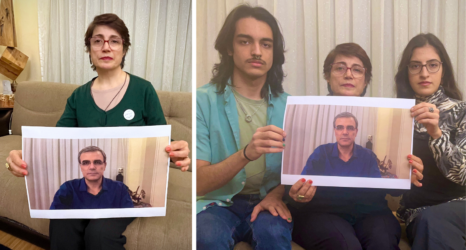Amanda Maldonado sits near the fitting rooms of The Outrage, a clothing store in the Adams Morgan area of Washington D.C., surrounded by boxes of apparel shipments. Her oversized glasses and knit hat that says “RESIST” almost touch her laptop screen. As creative director, she usually interacts with customers, eager to hear their thoughts on feminism and the shop’s items. Today, however, she’s focused on finishing new designs.
In addition to selling clothing and accessories with phrases such as “Nasty Woman,” “Nevertheless, She Persisted,” “Queer Folk Unite,” and “I Believe in Science,” The Outrage is a space that encourages conversation and activism. The back area of the store, where Maldonado sits, is large enough for feminists to relax and talk, strategize, or to hold formal events having to do with activism. There’s a lending library of feminist books customers can sign out, as well as a list of bills that threaten people’s rights, health, safety, and the environment and materials to write postcards to Congressional representatives—which they will even mail for you. Money is crammed into a donations jar for Planned Parenthood next to the register, and a minimum of 15 percent of every purchase goes to Planned Parenthood or the ACLU. So far they have donated nearly $100,000.
The Outrage launched six months ago with a focus on feminism and women’s empowerment. CEO Rebecca Lee Funk sought to blend style and activism. When Donald Trump became president, sales immediately skyrocketed. Funk became an official partner of the Women’s March, and decided her pop-up operation would remain open indefinitely. She hired Maldonado, who had never been a creative director, but produced several designs as a volunteer for The Outrage.
“Things just flowed between me and Rebecca,” Maldonado says. “It was one of those moments in life when you know you have met amazing people, and everything just fell into place.”
While Maldonado occasionally features the work of other artists, she designs most of the merchandise herself or with Funk.
“Every little design has a story behind it,” she says. “Most people don’t know that.”
She describes a shirt with faces of several different women on it, sketched as composites of people in her life, including her mother. For Maldonado, this shirt epitomizes intersectional feminism, though she doesn’t want to advertise it as such, since the number of faces on it—and therefore the diversity—is limited for space.
Maldonado never imagined she’d work in the arts. She was raised in a well-to-do, Roman Catholic, Puerto Rican household in Freehold, New Jersey. Although she’s a proud Latina, she easily passes as white, an inequity that has shaped her desire to advocate for equality. In middle school, she was assigned to a predominately white bus and a predominately white school. The darker-skinned students from her neighborhood took a different bus to a more racially and ethnically diverse school. When they came together in high school, the darker-skinned Latina girls were upset that she spoke fluent Spanish but passed as white.
“They didn’t understand me,” she says. “And maybe I didn’t understand them.”
She hadn’t personally experienced how the schools, the teachers—the system—was against them. At a young age, Maldonado decided that in order to make her family proud she had to become a lawyer, though they never pressured her. She saw art and design as hobbies and her short, shaggy haircut as something she’d have to grow out as an adult.
“I thought I’d have to close off that part of myself because of societal expectations,” she says. She thought she couldn’t be herself—including openly identifying as queer—and also be taken seriously as an individual trying to make a difference in the world. Living in Seoul, South Korea after college changed that.
For two years, Maldonado taught English and spent time in art museums. She met a queer man there named Ookjay Chung who created art solely for personal fulfillment. He inspired her artistically, personally, and gave her the courage to share her designs, which is how she got her job at The Outrage. “I use art as a way to figure myself out and the world around me,” she says. “I walk calmly around a museum, and as time goes by I can feel how much the art influenced me, inspired me, and got me to think about things with a different perspective.”
Although feminist apparel has been popular these days, Maldonado rejects the idea that feminism can come in and out of style.
“Some people who come here do it because it’s a trend,” she says. “And I try to be clear: feminism is not a trend. We’re not about ‘Let’s sell feminist apparel.’ We’re about women’s purchasing power being used to make a difference. We’re about donations. Having a space for conversations. That’s the point of The Outrage. If you disagree or don’t understand, fine. Let’s talk about it. We want to talk about it. This is a movement, not a moment.”
Samantha Paige Rosen has written for The Washington Post, The Week, The Philadelphia Inquirer, The Huffington Post, Bustle, Attn, and Beautiful Minds Magazine. In addition to contributing writing and research to HBO, VICE, and A&E television shows, she has her own business, Samantha Paige Rosen Writing and Research.





